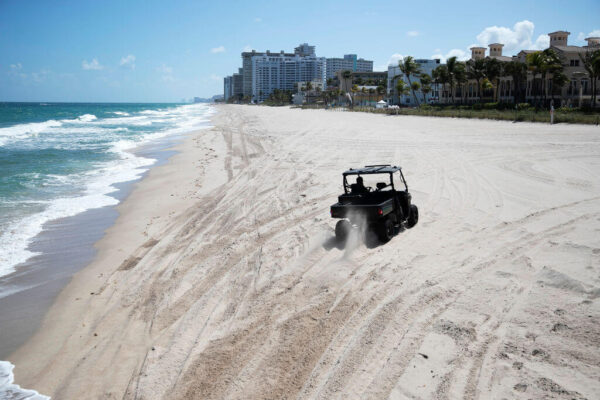Girl Buried Alive In Florida Likely Got Trapped and Suffocated in Sand, Experts Say – Vital Tips to Survive If It Happens to Your Family
A 7-year-old Indiana girl who died after being buried alive in the sand on a Florida beach most likely suffocated as the weight of the shifting ground prevented the child from breathing and presumably obstructed her airway, medical experts said.
Sloan Mattingly died Feb. 20 in Lauderdale-by-the-Sea while on vacation with her parents.
She and her 9-year-old brother, Maddox, were playing in a deep hole they had dug on the beach when it collapsed, trapping both children beneath the ground.
No lifeguards were stationed on the beach at the time.
The incident highlighted the danger of digging holes on the beach, which can turn deadly in collapse as the crushing weight of sand pins the arms and prevents a person from moving, making it impossible to dig out, said Dr. James Gill, Chief Medical Examiner of Connecticut.
“There are two ways that death can result in this scenario,” Gill told Atlanta Black Star. “One is asphyxia due to lack of oxygen as there is little air available to breathe, and the sand can block the airway. The other mechanism is compression of the chest. If the sand is heavy enough, the weight can prevent a person from being able to breathe in and out. These types of deaths also can occur at construction sites when digging deep trenches for sewer pipes, for example.”
Gill emphasized prevention as the best way to avoid a similar tragedy.
“Do not go into these holes,” he warned. “Similar things can happen with snow avalanches or sand dunes that shift.”
Dr. Kofi A. Afrifah, a criminal justice expert at Bowie State University in Maryland, warned parents to keep a close eye on children at the beach as the sand was a “hidden danger” in what’s otherwise a breezy destination for a family getaway.
“Children can get trapped in many ways. For example, children like to dig holes or tunnels to create pits in the sand when they are playing,” Afrifah explained. “The pit created may cave in unexpectedly, trapping them beneath the weight of the sand if the sand is not compacted properly or if the hole is dug too deep. This can lead to fatalities.”
He highlighted other dangers, including incoming tidal waves, unstable sandbanks, and children left unattended by adults.
“It is therefore imperative for adults to set boundaries for children and closely monitor them when they are playing in the sand and educate them about the potential dangers. Additionally, children should be encouraged to avoid digging pits and tunnels in the beach sand that may be too deep to avoid entrapment, which can lead to panic attacks, trauma, suffocation, and hypothermia.”
Afrifah said authorities should install warning signs on beaches to encourage visitors to be cautious in areas prone to sand collapses. They should also have well-defined emergency response protocols in place to respond to incidents of sand entrapment, he said.
Last week’s tragedy in Lauderdale-by-the-Sea was a rare case in which such incidents turn deadly each year in coastal communities across the United States.
This time, fate struck unexpectedly as two kids were playing in the sand near Anglin’s Fishing Pier on El Mar Drive around 3 p.m. last Tuesday in Lauderdale-by-the-Sea.
Pompano Beach Fire Rescue immediately responded to the scene, but it was already too late for one of the children.
The older sibling was buried up to his chest and survived, but when paramedics found Sloan, she was unresponsive and later pronounced dead.
Maddox is in stable condition at Broward Health Medical Center.
The parents have not been identified. The Broward Sheriff’s Office is investigating.
The hole the children dug purportedly reached a depth of 5 to 6 feet, while lifeguards in neighboring beach communities are trained to warn beachgoers not to dig sand deeper than 2 feet.
Witnesses filmed video of the harrowing scene as bystanders tried desperately to save the children before first responders arrived.
Rescuers used shovels and supportive boards to prevent the sand from collapsing further as they tried to reach the girl, officials said.
A 911 call released by the Sheriff’s Office captured a woman struggling for breath and frantically telling the operator, “There’s a little girl buried in the sand.”
It was unclear how long the children were submerged, with the girl coming to rest underneath her brother.
Later, a spokesperson for Lauderdale-by-the-Sea said crews filled the hole and leveled off the beach the next day.
Facing prompt scrutiny, Lauderdale-by-the-Sea Mayor Chris Vincent said the town commission had been considering the possibility of hiring Pompano Beach EMTs for regular lifeguard services when the tragic incident occurred.
However, he said he didn’t want to speculate whether lifeguards would have altered the outcome, though rescue experts suggested that their presence might have prevented the tragedy.
“This doesn’t happen on guarded beaches,” Jim McCrady, a surf rescue chief in Hallandale Beach, told the South Florida Sun-Sentinel. “We do that all day long. We spot hazards, and then we mitigate the dangers involved in those hazards. This is a daily thing that happens on a guarded beach when someone starts to dig a hole. We not only tell the person not to dig a deep hole but to fill it in before they leave.”
Tom Gill, vice president of the United States Lifesaving Association, told The New York Times that up to three people in the country are killed each year by collapsing sand at beaches.
Children are almost always the most likely victims.
Gill emphasized the unpredictability of beach sand, saying a safe guideline is to never dig a hole deeper than the knee height of the smallest person who will enter it.

